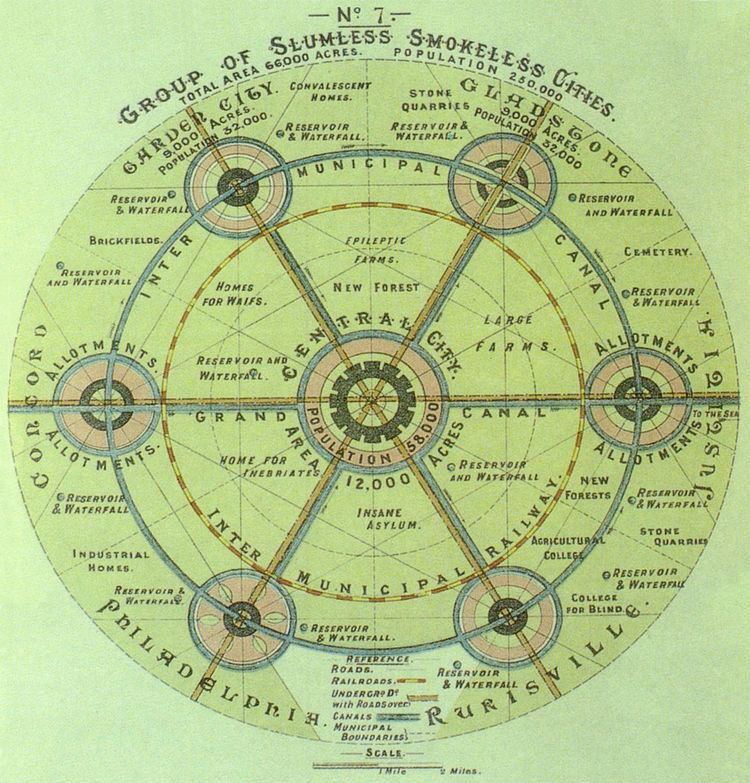 | ||
Unified settlement planning (USP) is the component of regional planning where a unified approach is applied for a region's overall development. The USP approach is most often associated with urban planning practices in India.
Contents
Overview
Regions use their land in for various purposes, including agriculture, manufacturing, and public administration. For society to develop, it has to amalgamate and develop settlements; their coexistence is the basis for a holistic development of any society.
Unified settlement planning is a contemporary approach for the bulk requirement of urban amenities, for the vast regions of the developing countries with uniformly distributed human settlement patterns. The approach is gaining importance in India, primarily due to the difficulties posed by the high density of existing rural settlements, in implementing the conventional plans with contiguous urban zones, around pre‑existing cities. The approach utilizes the advantages of the uniformly distributed human settlement patterns and avoids the difficulties caused by the dense network of roads and villages, all over the regions. Unified settlement planning allows holistic regional development without significantly disturbing existing villages, farmland, bodies of water, and forests.
History
Sir Ebenezer Howard (29 January 1850– May 1, 1928) is known for his publication Garden Cities of To-morrow (1898), the description of a utopian city in which people live harmoniously together with nature, which forms the basis for unified settlement planning. The publication resulted in the founding of the garden city movement, that realized several Garden Cities in Great Britain at the beginning of the 20th century.
Walter Christaller (April 21, 1893 – March 9, 1969) who was a German geographer, developed the idea of Central Place Theory. It stated that settlements simply functioned as 'central places' providing services to surrounding areas.
August Lösch (October 15, 1906 in Öhringen-) a German economist, is regarded as the founder of Regional Science. August Lösch expanded on Christaller’s work in his book 'The Spatial Organization of the Economy'(1940). Unlike Christaller, whose system of central places began with the highest-order, Lösch began with a system of lowest-order (self-sufficient) farms, which were regularly distributed in a triangular-hexagonal pattern. He thought that Christaller's model led to patterns where the distribution of goods and the accumulation of profits were based entirely on location. He instead focused on maximizing consumer welfare and creating an ideal consumer landscape where the need to travel for any good was minimized and profits were held level, not maximized to accrue extra.
Mohandas Karamchand Gandhi visioned for a free country governed by their own people;he penned down his visions in a book Hind Swaraj or Indian Home Rule in 1909.Swaraj stated that every village should be its own republic, "independent of its neighbours for its own vital wants and yet interdependent for many others in which dependence is necessary". A decentralized, unexploited, co-operative, self-reliant and peace-loving development of a region is must for development of India.
These ideas of swaraj was developed in light of contemporary scenario in India as Providing Urban Amenities to Rural Areas (PURA), envisioned by former president of India and an eminent scientist Dr A. P. J. Abdul Kalam and framed by Prof. Emerson.
PURA proposes that urban infrastructure and services be provided in rural hubs to create economic opportunities outside of cities. These ideas will be possible through physical connectivity by providing roads, electronic connectivity by providing communication network and knowledge connectivity by establishing professional and Technical institutions. The mentioned programs will have to be done in an integrated way so that economic connectivity will emanate. The Indian central government has been running pilot PURA programs in several states since 2004.
Recent developments
Chhattisgarh, one of the fastest growing states of India, has initiated deliberations on the subject, for its development strategies. The process has started with some useful studies and research on the area by Dr. Devendra K. Sharma.
Based on a comprehensive scheme on the Unified settlement Plan for India (USP for India), targeted to serve the whole nation in future, the Chhattisgarh government is contemplating a project for the holistic development of a regional module of about 700 km2. area, enclosed between the highways connecting Durg, Ragnandgaon & Khairagarh.
Institute of Town Planners, India (ITPI) organised a national seminar on the subject of Urban Dynamics and Planning - 2032, on 18 & 19 April 2012. The seminar has strongly recommended that the development of rural and urban settlements in India should not be planned separately.
Principles
The fundamental objective for a unified settlement plan includes:
The strategies for achieving the objectives include:
